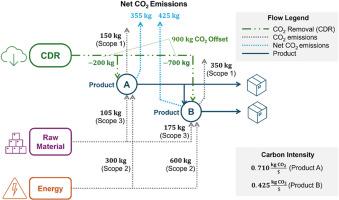多产品企业碳信用最优分配的模糊线性规划
IF 6.5
Q2 ENGINEERING, ENVIRONMENTAL
引用次数: 0
摘要
净零排放承诺给企业带来压力,要求它们采取缓解措施,如提高能源效率和减少化石燃料的使用,使其业务和产品脱碳。此外,可以从供应商那里购买二氧化碳去除积分,以对难以减少的排放进行积分。有必要分配这些信用额,以满足特定产品的碳足迹减少和成本目标;为这些决策提供有效的基于模型的支持是一个新出现的挑战。本文提出了一种模糊线性规划模型来弥补这一研究空白。该模型基于环境扩展的企业投入产出模型,该模型允许对每种产品的碳足迹和生产成本进行一致的计算。当信用额从外部供应商购买并分配到企业内部运营时,碳足迹的减少和增量成本都通过中间流在生产系统中传播。根据公司定义的碳足迹减少目标和增量成本限制,对碳信用额进行最优分配。该模型首先在一个简单的教学案例研究中得到验证。然后将其应用于生产一套电子硬件和软件产品的企业集团的工业案例研究;碳足迹减少了40%,而大多数产品的增量生产成本不到1%。这些例子说明了企业如何更有效地利用碳信用额度来降低其产品组合的碳排放。本文章由计算机程序翻译,如有差异,请以英文原文为准。

A fuzzy linear program for optimal allocation of carbon credits in multi-product firms
Net zero commitments put pressure on companies to decarbonize their operations and products with mitigation measures such as improving energy efficiency and reducing fossil fuel use. In addition, carbon dioxide removal credits can be purchased from vendors to credit hard-to-abate emissions. It is necessary to allocate these credits to meet product-specific carbon footprint reduction and cost targets; providing effective model-based support for such decisions is an emerging challenge. A fuzzy linear programming model is developed here to address this research gap. The model is based on an environmentally-extended enterprise input-output model, which allows consistent computation of the carbon footprint and production cost of each product. When credits are purchased from an external vendor and distributed to the firm's internal operations, both the carbon footprint reduction and the incremental cost propagate through the production system via intermediate streams. The carbon credits are allocated optimally given company-defined carbon footprint reduction targets and incremental cost limits. The model is first demonstrated in a simple pedagogical case study. It is then applied to an industrial case study of a conglomerate producing a suite of electronics hardware and software products; carbon footprints are reduced by 40 % with an incremental production cost of less than 1 % for most of the products. These examples show how firms can use carbon credits more effectively to decarbonize their product portfolios.
求助全文
通过发布文献求助,成功后即可免费获取论文全文。
去求助
来源期刊

Cleaner Engineering and Technology
Engineering-Engineering (miscellaneous)
CiteScore
9.80
自引率
0.00%
发文量
218
审稿时长
21 weeks
 求助内容:
求助内容: 应助结果提醒方式:
应助结果提醒方式:


